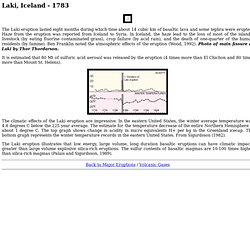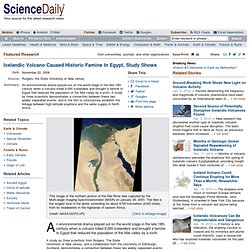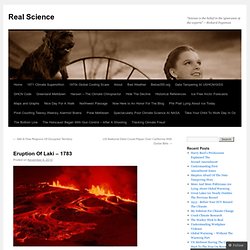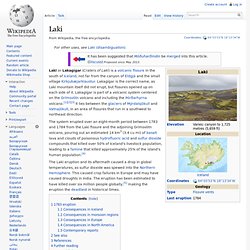

Iceland: Katla Volcano. Laki, Iceland - 1783. The Laki eruption lasted eight months during which time about 14 cubic km of basaltic lava and some tephra were erupted.

Haze from the eruption was reported from Iceland to Syria. In Iceland, the haze lead to the loss of most of the island's livestock (by eating fluorine contaminated grass), crop failure (by acid rain), and the death of one-quarter of the human residents (by famine). Ben Franklin noted the atmospheric effects of the eruption (Wood, 1992). Photo of main fissure at Laki by Thor Thordarson. It is estimated that 80 Mt of sulfuric acid aerosol was released by the eruption (4 times more than El Chichon and 80 times more than Mount St. The climatic effects of the Laki eruption are impressive. The Laki eruption illustrates that low energy, large volume, long duration basaltic eruptions can have climatic impacts greater than large volume explosive silica-rich eruptions. Back to Major Eruptions / Volcanic Gases. Icelandic Volcano Caused Historic Famine In Egypt, Study Shows. An environmental drama played out on the world stage in the late 18th century when a volcano killed 9,000 Icelanders and brought a famine to Egypt that reduced the population of the Nile valley by a sixth.

A study by three scientists from Rutgers, The State University of New Jersey, and a collaborator from the University of Edinburgh, Scotland, demonstrates a connection between these two widely separated events. The research was funded by the National Science Foundation and the National Aeronautics and Space Administration (NASA). The investigators used a computer model developed by NASA's Goddard Institute for Space Studies to trace atmospheric changes that followed the 1783 eruption of Laki in southern Iceland back to their point of origin.
The study is the first to conclusively establish the linkage between high-latitude eruptions and the water supply in North Africa. These eruptions were followed by a drought in a swath across northern Africa, producing a very low flow in the Nile. Eruption Of Laki – 1783. Eruption Of Laki – 1783 In 1783, the Laki volcano in Iceland erupted.

Gases from the volcano killed most of the island’s livestock and as a result – one fourth of the human population starved to death. Winter temperatures in the US dropped almost 10F and stayed below normal for several years. Like this: Like Loading... About stevengoddard Just having fun. Laki. Laki or Lakagígar (Craters of Laki) is a volcanic fissure in the south of Iceland, not far from the canyon of Eldgjá and the small village Kirkjubæjarklaustur.

Lakagígar is the correct name, as Laki mountain itself did not erupt, but fissures opened up on each side of it. Lakagígar is part of a volcanic system centered on the Grímsvötn volcano and including the Þórðarhyrna volcano.[1][2][3] It lies between the glaciers of Mýrdalsjökull and Vatnajökull, in an area of fissures that run in a southwest to northeast direction. The system erupted over an eight-month period between 1783 and 1784 from the Laki fissure and the adjoining Grímsvötn volcano, pouring out an estimated 14 km3 (3.4 cu mi) of basalt lava and clouds of poisonous hydrofluoric acid and sulfur dioxide compounds that killed over 50% of Iceland's livestock population, leading to a famine that killed approximately 25% of the island's human population.[4] 1783 eruption[edit] Consequences in Iceland[edit]